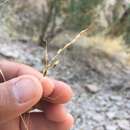Common Names
(
englanti
)
tarjonnut Fire Effects Information System Plants
pinyon ricegrass
dropseed
- bibliografinen lainaus
- Reeves, Sonja L. 2008. Piptochaetium fimbriatum. In: Fire Effects Information System, [Online]. U.S. Department of Agriculture, Forest Service, Rocky Mountain Research Station, Fire Sciences Laboratory (Producer). Available: https://www.fs.fed.us /database/feis/plants/graminoid/pipfim/all.html
Conservation Status
(
englanti
)
tarjonnut Fire Effects Information System Plants
Information on state-level protected status of plants in the United States is available at
Plants Database.
- bibliografinen lainaus
- Reeves, Sonja L. 2008. Piptochaetium fimbriatum. In: Fire Effects Information System, [Online]. U.S. Department of Agriculture, Forest Service, Rocky Mountain Research Station, Fire Sciences Laboratory (Producer). Available: https://www.fs.fed.us /database/feis/plants/graminoid/pipfim/all.html
General Information On Distribution
(
englanti
)
tarjonnut Fire Effects Information System Plants
More info for the terms:
density,
forest,
phaseGENERAL INFORMATION ON DISTRIBUTION GENERAL DISTRIBUTION:
Pinyon ricegrass is native to North America, occurring from southern Arizona to western Texas and southward into Mexico [9,15,19,25,30]. It also occurs in Guatemala [5]. Grass Manual on the Web provides a distributional map of pinyon ricegrass.
HABITAT TYPES AND PLANT COMMUNITIES:
Pinyon ricegrass commonly occurs in pinyon-juniper woodlands of Arizona and New Mexico [8]. It is also known to occur in encinal oak woodlands of Arizona [20]. In western Texas, pinyon ricegrass is present in oak-scrub (chaparral) communities dominated by dwarf oak (Quercus intricata) [7]. Pinyon ricegrass occurs at low density in the ponderosa pine-Colorado pinyon-gray oak (Pinus ponderosa-P. edulis-Quercus grisea) community type in southwestern New Mexico [21].
Pinyon ricegrass is a dominant species in the following vegetation types.
Arizona/New Mexico: - Chihuahua pine (Pinus leiophylla)/pinyon ricegrass [1,2,3,6,34]
- Arizona white oak (Quercus arizonica)/pinyon ricegrass [3]
- border pinyon (Pinus discolor)/pinyon ricegrass [3,34].
- Colorado pinyon-Arizona white oak/pinyon ricegrass [34]
Lincoln National Forest, New Mexico: - border pinyon-Mexican pinyon (Pinus cembroides)/pinyon ricegrass/Arizona white oak phase [26]
Big Bend National Park, Texas: - Arizona cypress (Cupressus arizonica)/alligator juniper (Juniperus deppeana)/pinyon ricegrass [22].
- bibliografinen lainaus
- Reeves, Sonja L. 2008. Piptochaetium fimbriatum. In: Fire Effects Information System, [Online]. U.S. Department of Agriculture, Forest Service, Rocky Mountain Research Station, Fire Sciences Laboratory (Producer). Available: https://www.fs.fed.us /database/feis/plants/graminoid/pipfim/all.html
Life Form
(
englanti
)
tarjonnut Fire Effects Information System Plants
More info for the term:
graminoidGraminoid
- bibliografinen lainaus
- Reeves, Sonja L. 2008. Piptochaetium fimbriatum. In: Fire Effects Information System, [Online]. U.S. Department of Agriculture, Forest Service, Rocky Mountain Research Station, Fire Sciences Laboratory (Producer). Available: https://www.fs.fed.us /database/feis/plants/graminoid/pipfim/all.html
Taxonomy
(
englanti
)
tarjonnut Fire Effects Information System Plants
The scientific name of pinyon ricegrass is Piptochaetium fimbriatum (H.B.K.)
Hitch (Poaceae) [
13,
14,
15,
19].
- bibliografinen lainaus
- Reeves, Sonja L. 2008. Piptochaetium fimbriatum. In: Fire Effects Information System, [Online]. U.S. Department of Agriculture, Forest Service, Rocky Mountain Research Station, Fire Sciences Laboratory (Producer). Available: https://www.fs.fed.us /database/feis/plants/graminoid/pipfim/all.html
Comprehensive Description
(
englanti
)
tarjonnut North American Flora
Piptochaetium fimbriatum (H.B.K.) Hitchc. Jour. Wash Acad. Sci. 23:453. 1933.
Slipa fimbriata H.B.K. Nov. Gen. & Sp. 1: 126. 1815. (Type from Mexico.)
Milium mexicanum Spreng. Syst. Veg. 1: 251. 1825. (Type from Mexico.)
Piplatherum mexicanum SohnXXes. in R. & S. Syst. Veg. Mant. 3: Addit. 564. 1827. (Based on
Milium mexicanum Spreng.) Avena slipoides Steud. Nom. Bot. ed. 2. 2; 146. 1841 . (As synonvm of Milium mexicanum Spreng.) Oryzopsis Jimbriata Hemsl. Biol. Centr. Am. Bot. 3: 538. 1885. (Based on Slipa fimbriala H.B.K.)
- bibliografinen lainaus
- Albert Spear Hitchcock. 1935. (POALES); POACEAE (pars). North American flora. vol 17(6). New York Botanical Garden, New York, NY
Physical Description
(
englanti
)
tarjonnut USDA PLANTS text
Perennials, Terrestrial, not aquatic, Stems nodes swollen or brittle, Stems erect or ascending, Stems caespitose, tufted, or clustered, Stems terete, round in cross section, or polygonal, Stem internodes hollow, Stems with inflorescence less than 1 m tall, Stems, culms, or scapes exceeding basal leaves, Leaves mostly basal, below middle of stem, Leaves conspicuously 2-ranked, distichous, Leaves sheathing at base, Leaf sheath mostly open, or loose, Leaf sheath smooth, glabrous, Leaf sheath and blade differentiated, Leaf blades linear, Leaf blades very narrow or filiform, less than 2 mm wide, Leaf blade margins folded, involute, or conduplicate, Leaf blades mostly glabrous, Ligule present, Ligule an unfringed eciliate membrane, Inflorescence terminal, Inflorescence simple spikes, Inflorescence an open panicle, openly paniculate, branches spreading, Inflorescence solitary, with 1 spike, fascicle, glomerule, head, or cluster per stem or culm, Inflorescence with 2-10 branches, Inflorescence branches more than 10 to numerous, Inflorescence branches paired or digitate at a single node, Flowers bisexual, Spikelets pedicellate, Spikelets laterally compressed, Spikelet less than 3 mm wide, Spikelets with 1 fertile floret, Spikelets solitary at rachis nodes, Spikelets all alike and fertille, Spikelets bisexual, Spikelets disarticulating above the glumes, glumes persistent, Rachilla or pedicel glabrous, Glumes present, empty bracts, Glumes 2 clearly present, Glumes equal or subequal, Glumes equal to or longer than adjacent lemma, Glumes 3 nerved, Glumes 4-7 nerved, Lemma coriaceous, firmer or thicker in texture than the glumes, Lemma becoming indurate, enclosing palea and caryopsis, Lemma 5-7 nerved, Lemma body or surface hairy, Lemma apex truncate, rounded, or obtuse, Lemma distinctly awned, more than 2-3 mm, Lemma with 1 awn, Lemma awn 1-2 cm long, Lemma awned from tip, Lemma awn twisted, spirally coiled at base, like a corkscrew, Lemma awn twice geniculate, bent twice, Lemma margins thin, lying flat, Lemma apices fused distally into a crown, Lemma straight, Callus or base of lemma evidently hairy, Callus hairs shorter than lemma, Palea present, well developed, Palea membranous, hyaline, Palea about equal to lemma, Palea 2 nerved or 2 keeled, Stamens 3, Styles 2-fid, deeply 2-branched, Stigmas 2, Fruit - caryopsis, Caryopsis ellipsoid, longitudinally grooved, hilum long-linear.

